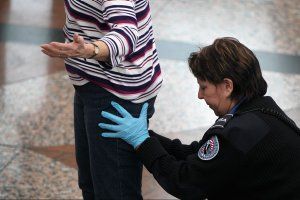
On September 11, 2001, I was sitting in my office at Tel Aviv's Ben Gurion airport, where I was director of security, and watched in horror as the world changed. During the next few months, I saw America quickly identify screenings as the source of all evil and the reason for the attacks—despite, illogically, the fact that Mohamed Atta and his terrorist teams didn't carry any weapons that were supposed to be detected at the checkpoints.
I've since moved to the U.S. to consult on airport security. Time after time, I've watched the country react retroactively—making us take off our footwear after Richard Reid's attempted shoe bombing, deciding not to let us bring water or shampoo on flights after a failed plot to blow up planes with liquid explosives, and, now, subjecting passengers to full-body scans or invasive searches after last December's thwarted underwear bombing. It's time to accept that terrorist attacks are not carried out by things but by people. A security strategy based on detection technology alone is a failed one. Our great love of gadgetry—and the belief that it can solve all our problems, without a personal touch—has only led to one failure after another.
Looking for better solutions takes me back to Ben Gurion. Israeli aviation security manages to create a reasonable balance between detection technology and human interaction. While at American airports we deploy people to support technology, in Tel Aviv technology is deployed to support people. Does it work? Ask Anne Marie Murphy, a young Irishwoman who, in 1986, nearly boarded a plane while carrying an explosive device without her knowledge. Her terrorist boyfriend, who was supposed to be on a separate flight, had given her a bag with a concealed bomb. When a profiler began to ask her a standard set of questions, it became clear that she was an anomaly (she had no accommodations lined up, among other issues). The device, which was cleverly hidden, would not have been detected during a pat-down, or even by an X-ray scanner. But the profiler, who was not distracted by her ethnicity, religion, gender, or her obvious pregnancy, saved Murphy and hundreds of other passengers—simply by taking her aside and talking to her.
The Murphy case illustrates the limitations of ethnic and racial profiling. Not only does the P word contradict values so dear to us, it's just not the smartest tactic. Analyzing someone's behavior through observation and conversation—in real time and cumulatively—makes more sense. Screeners should be able to comb through a more comprehensive database of government and law-enforcement data as well as information from the airlines about, say, who has paid cash for a ticket and who is flying one way. These "tells" are unusual and would cause screeners to pay closer attention when it matters. (They're also the behaviors that Atta, Reid, and the "underpants bomber" displayed.) Which is what's needed: by relying on a one-size-fits-all approach to security, we spend too much time searching harmless travelers—and too little time rooting out legitimate threats.
Ron is CEO of New Age Security Solutions Inc. in Dulles, Va.
Uncommon Knowledge
Newsweek is committed to challenging conventional wisdom and finding connections in the search for common ground.
Newsweek is committed to challenging conventional wisdom and finding connections in the search for common ground.
About the writer
To read how Newsweek uses AI as a newsroom tool, Click here.








